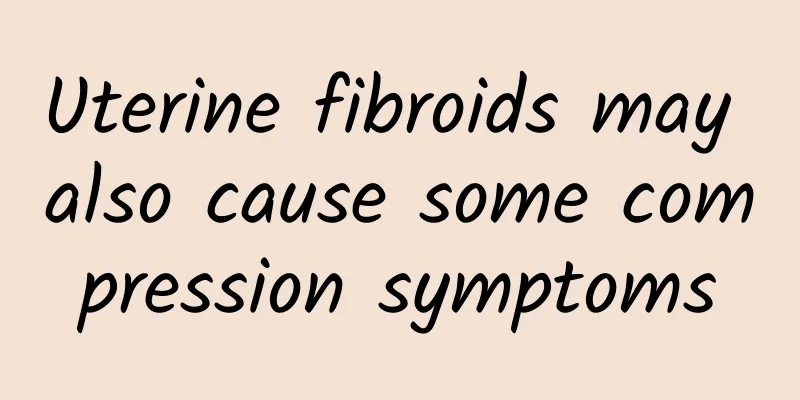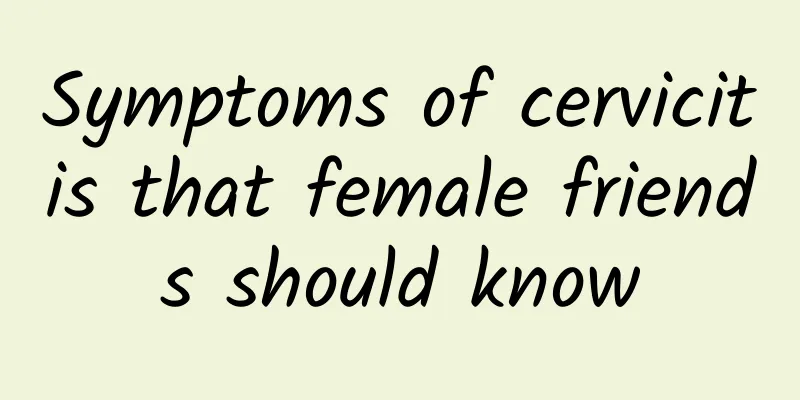Uterine fibroids may also cause some compression symptoms

|
Uterine fibroids may also cause some compression symptoms. Patients can see a series of compression symptoms from the anterior wall of the uterus. Do you know what the symptoms of uterine fibroids are? This is a question that people ask a lot. Let the experts explain it to you in detail. The symptoms of uterine fibroids mainly include the following: 1) Abdominal masses are often discovered by chance or during a general examination. 2) Vaginal bleeding is the most common symptom of uterine fibroids. Subserosal uterine fibroids usually do not cause vaginal bleeding. When intramural fibroids are large, they may affect uterine contraction or increase the area of the endometrium, causing excessive menstruation or prolonged menstruation. If it is a submucosal fibroid, there may be irregular vaginal bleeding, which is continuous. 3) Abdominal pain Fibroids generally do not cause abdominal pain, but when they undergo degeneration or when subserosal uterine fibroids twist, they can cause severe abdominal pain. Submucosal fibroids can also cause dysmenorrhea. 4) Increased leucorrhea is also a common symptom of uterine fibroids. When there are superficial ulcers on the surface of submucosal fibroids, the leucorrhea may increase, and when there is infection, there may be purulent leucorrhea. 5) Compression symptoms. Different compression symptoms may occur due to the different growth sites and sizes of uterine fibroids. For example, if the fibroids grow on the anterior wall of the uterus, they may compress the bladder and cause frequent urination, urgency, or even urinary retention; if the fibroids grow on the posterior wall of the uterus, they may compress the rectum and cause constipation; fibroids that occur in the broad ligament may compress the ureters, internal and external iliac veins, and nerves, resulting in ureteral obstruction, hydronephrosis, lower limb edema, or neuralgic pain, which are all symptoms of uterine fibroids. 6) Infertility can be caused by uterine fibroids changing the morphology of the uterine cavity, or by fibroids hindering the implantation of the fertilized egg, or by uterine fibroids growing in the uterine cornu, blocking sperm from entering the fallopian tube, or by uterine fibroids complicated by ovarian dysfunction, etc. 7) Circulatory system symptoms: Long-term menorrhagia can cause secondary anemia. 90% of patients with submucosal fibroids have anemia, and those with severe anemia may have anemic heart disease. In addition, fibroid patients often have hypertension accompanied by headaches. After the fibroid is removed, blood pressure often drops to normal, but the relationship between hypertension and fibroids is unclear. These are all symptoms of uterine fibroids. The above are the symptoms of uterine fibroids introduced by experts. I hope it can help you. If you still want to know what precautions to take, please consult experts online. They will give you a satisfactory explanation. Thank you for your support and trust in this website. |
<<: Uterine fibroids may be associated with infertility
>>: The most common causes of pelvic inflammatory disease
Recommend
Understand these care points for vulvar leukoplakia
Understand the key points of care for vulvar leuk...
Can women with chronic cervicitis not be treated? How can patients with chronic cervicitis regulate themselves?
Chronic cervicitis is an inflammatory reaction of...
What does a drop in hcg mean for ectopic pregnancy
A decrease in HCG in an ectopic pregnancy general...
What is the best way to treat pelvic effusion?
Pelvic effusion usually occurs in the lower part ...
The harm of ovarian cysts that female friends need to pay attention to
In real life, the harm of ovarian cysts needs to ...
Cervicitis remedies
Cervicitis usually occurs in women of childbearin...
Brief analysis of the dietary therapy for the treatment of chronic pelvic inflammatory disease
In clinical practice, chronic pelvic inflammatory...
Advances in diagnosis and treatment of bacterial vaginosis
Bacterial vaginosis was once named Haemophilus va...
Analysis of common examination and diagnosis methods for pelvic inflammatory disease
It is very important for female patients with pel...
Timely detection of pelvic inflammatory disease symptoms can effectively control the disease
Nowadays, most women are prone to pelvic inflamma...
Fasting to lose weight and reduce body fat is not just about 168! A complete guide to 7 fasting methods, with 6 points to make fasting more effective
There are many different ways to do intermittent ...
Tips to relieve dysmenorrhea in women
Some women will feel unbearable pain when they en...
What is the pain in the lower body after miscarriage?
What's wrong with lower body pain after misca...
Xuefu Zhuyu Decoction cures functional uterine bleeding
Young and beautiful Xiaolin, although only 25 yea...
How does skipping rope prevent ectopic pregnancy?
Rope skipping is a very good sport. It can not on...









